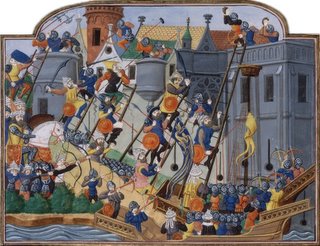Sapping and Mining II.

This is coolbert:
Conclusion!
One would have thought that with the advent of gunpowder and cannon, the age of sapping and mining has ended.
But that is not the case.
Now, it is true that gunpowder and cannon did end the age of walled cities such as Constantinople. The walls of Constantinople were never breached in all their history until the Turkish siege of 1453. Using massive brass cannon and stone cannon balls, the Turks were finally able to do what no besieger previously had been able to do, pierce the walls of the city! After this massive walled constructs of the like of Constantinople were rendered useless and were never again built.
But this was not the end of sapping and mining! This technique of dealing with fortifications continued, albeit in an altered form, even unto recent times.
During what is called the era of "magazine" warfare, forts of amazing complexity continued to be built.
These forts even proved to be relatively impervious even to cannon fire!?
One response to the forts of this era was for the attacker to employ another method of sapping and mining called fingers and laterals, also called zig-zags and parallels [click here to see a description of the zig-zag and parallel system]. Trenches were dug by sappers first leading directly from the attacker toward the defending fort, followed by lateral trenches to surround the fort closely from all directions. This system of trenches allows the attackers to approach closely the fort being attacked without exposing themselves to direct fire.
The Union side in the American Civil War and the British in World War One [WW1] both employed sapping and mining, and combined it with gunpowder, in an effort to overcome formidable trench defenses.
Union miners from Pennsylvania dug a tunnel and a massive cavern under the Confederate trench system at Petersburg, packed it with gunpowder, and detonated it. The resultant battle became known as the "Battle of the Crater". Named for the huge crater formed from the detonation. The resultant attack of Union troops, however, was a failure, as the terrain of the crater was not passable, even by soldiers on foot. The attack was repelled by Confederate forces. This battle is the first scene of the movie, "Cold Mountain".
A similar situation existed during World War One in Belgium.
British miners dug six tunnels and caverns under the German trench system, and also packed those six caverns with gunpowder. When detonated, each explosion was on the level of a tactical nuclear weapon!!
The gain for all this effort was meager however, and one must ask if the gain was worth the pain!? Again, results from the follow up attack by the British were scant.
Seems the same situation resulted in Belgium as had at Petersburg. The ground is so torn up and impassable that advance by even foot soldiers is not feasible.
The Royal Engineer, a Captain, was electrocuted in detonating the explosives in the caverns. Six caverns were filled with gunpowder, but only four of them detonated. And the exact location of the two unexploded caverns was lost. The general location is know, but to this day, somewhere in Belgium, are two huge caverns of explosives waiting to go off, each being equal to a tactical nuclear weapon!
It is also said that Lloyd George, then Prime Minister of England, waited quietly in his study in anticipation of the detonations, as he knew the exact time when they would occur, and that the shock of the explosions could be felt as far away as London, one hundred and twenty miles away!!.
Sapping and mining techniques as used during the "magazine" era were resurrected by the attacking Viet Minh during the siege at Dien Bien Phu [DBP] in 1954.
When seeming stalemate was reached during the siege [DBP], the Viet Minh began to duplicate the fingers and laterals as employed three hundred years earlier by besiegers of the "magazine" era. And again, the North Vietnamese did try the fingers and laterals technique at the siege of Khe Sanh in 1968, but with scant results.
The most up-to-date use of sapping and mining would be by the North Koreans.
A defector from North Korea has reputed that as many as twenty tunnels [only four have been found] have been dug from the North Korean side of the demilitarized zone [DMZ] into South Korea.
These are evidently sophisticated mine shafts dug with sophisticated imported drilling equipment, the mine shifts equipped with lighting, ventilation, and a tram way. Would be used by North Korean ranger/commando units emerging en masse either just prior to or during an invasion of South Korea by the North.
A commentator remarked that the boring of these tunnels through solid rock is just another indication of a favorite technique of communist subversion, boring from within and undermining! Surely within the definition of sapping and mining!
coolbert.

0 Comments:
Post a Comment
Subscribe to Post Comments [Atom]
<< Home